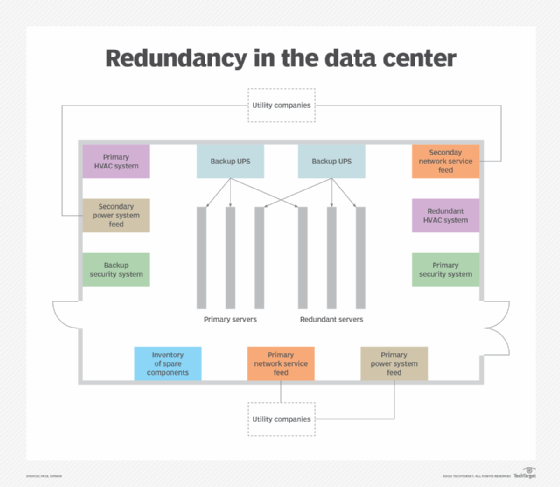Who Pays Redundancy Money? A Comprehensive Overview for Employers and Employees
Who Pays Redundancy Money? A Comprehensive Overview for Employers and Employees
Blog Article
Exploring the Operational Characteristics of Company Redundancy and Its Long-Term Sustainability

Redundancy Techniques for Organization Continuity
In order to make sure uninterrupted operations, businesses have to apply efficient redundancy techniques for organization continuity. Redundancy in this context describes the replication of vital parts or functions within a system to minimize the impact of potential failures. By incorporating redundancy approaches, companies can enhance their durability against interruptions triggered by various elements such as natural catastrophes, devices failings, or cyber-attacks.
One common redundancy technique is the application of backup systems and information storage services. This includes producing duplicates of crucial data and systems that can be activated in case of a primary system failing. Additionally, companies can develop repetitive interaction networks and source of power to maintain connection and procedures throughout unforeseen events.
Moreover, cross-training employees to perform numerous roles within the company can function as a beneficial redundancy approach. This makes certain that essential tasks can still be lugged out also if crucial employees are inaccessible as a result of health problem or other factors. In general, reliable redundancy strategies are necessary for services to promote functional continuity and decrease the effect of potential disturbances.
Effect of Redundancy on Organizational Strength
Provided the critical duty redundancy methods play in guaranteeing business connection, checking out the impact of redundancy on business resilience comes to be vital for comprehending the all natural operational characteristics of a company. Organizational resilience describes an entity's capacity to adapt to disturbances, recover from setbacks, and transform when essential while preserving core functions. Redundancy, when strategically carried out, can significantly contribute to enhancing a company's durability in the face of unforeseen obstacles. By having backup systems, personnel, or procedures in position, business can much better withstand shocks and continue procedures with marginal disruption.
Furthermore, redundancy can boost worker morale and self-confidence, understanding that there are backup strategies in area to deal with unanticipated conditions. This feeling of security can lead to enhanced efficiency and a much more positive work atmosphere. In addition, redundancy can foster development and imagination within an organization as workers feel equipped to take calculated threats, knowing that there is a safeguard to support them in case of failing. In general, the effect of redundancy on organizational resilience is extensive, forming the lasting sustainability and success of a business.
Stabilizing Effectiveness and Adaptability in Redundancy
Accomplishing an unified balance between functional performance and adaptive flexibility is a critical challenge in the tactical implementation of redundancy within companies. Also much adaptability without a strong functional structure can result in inadequacies and incongruity.
To stabilize effectiveness and versatility in redundancy preparation, companies have to thoroughly assess their operational needs, market dynamics, and tactical goals. Carrying out lean techniques can boost performance by simplifying procedures and eliminating waste, while cultivating a society of flexibility and continual renovation can enhance adaptability. Furthermore, buying cross-training programs and robust communication channels can help grow a functional labor force efficient in dealing with diverse tasks during periods of shift. Inevitably, finding the best balance between performance and adaptability is vital for constructing a resilient and lasting organization when faced with uncertainty.
Long-Term Sustainability With Redundancy Preparation
To make sure enduring feasibility and security, organizations must purposefully align their redundancy preparation with lasting sustainability objectives, consequently harmonizing operational performance with adaptive versatility. Long-term sustainability with redundancy preparation includes greater than simply temporary cost-cutting steps. It calls for an extensive critical method that prepares for future challenges and chances. Firms ought to watch redundancy not as a reactive option to prompt problems but as a positive method for long-term success. By integrating redundancy preparation with sustainability objectives, organizations can produce a resistant structure that can withstand different market variations and inner changes.

Positive Procedures for Sustainable Business Procedures
How can companies proactively enhance their operational sustainability for long-term success? Implementing aggressive procedures is essential for companies intending to make certain lasting procedures.
Moreover, promoting a culture of continuous renovation and understanding within the organization can improve versatility to transforming market problems and client demands. Encouraging employee participation in decision-making processes and offering possibilities for specialist advancement can increase spirits, efficiency, and overall efficiency. Establishing clear objectives, checking crucial performance signs, and consistently reviewing development are vital parts of proactive sustainability administration.
Working together with suppliers, clients, and other stakeholders to advertise lasting methods throughout the supply chain can create a causal sequence of favorable impact - redundancy pay if company goes bust. By taking positive steps in the direction of operational sustainability, business can build durability, drive innovation, and safeguard their long-term success in an ever-evolving service landscape
Conclusion

In the world of business administration, the tactical release of business redundancy stands as a pivotal yet intricate technique that requires a delicate balance in between operational efficiency and long-lasting viability. By studying the operational characteristics that underpin company redundancy and examining its wider effects for organizational strength and adaptability, a nuanced understanding of how redundancy methods can form the future trajectory of a business starts to unfold.Provided the critical duty redundancy strategies play in making sure business continuity, discovering the influence of redundancy on organizational strength becomes necessary for understanding the alternative operational characteristics of a company. In general, the influence of redundancy on business resilience is extensive, shaping the long-lasting sustainability and success of a firm.
In conclusion, understanding the operational dynamics of firm redundancy is essential for making sure lasting sustainability.
Report this page